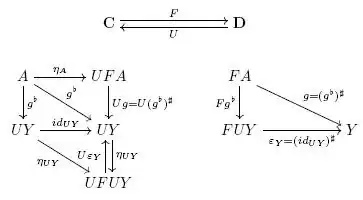I've having trouble understanding something in Turi's Category Theory Lecture Notes from The University of Edinburgh, which can be found here. It's the proof of Theorem 7.1, part (3).
Here's the statement of the theorem:
Given a functor $U:\mathbf{D}\to\mathbf{C}$, if for every object $A$ of $\mathbf{C}$ there exists a universal arrow $\eta _{A}: A\to UF_{A}$ from $A$ to $U$, then the following holds:
The function $F$ from objects of $\mathbf{C}$ to objects of $\mathbf{D}$ extends, by universality, to a functor $$F:\mathbf{C}\to\mathbf{D}$$ in the opposite direction to $U$.
The arrow $\eta _{A}$ is natural in $A$: $$\eta :Id\Rightarrow UF$$.
For every object $Y$ of $\mathbf{D}$ there is a universal arrow $\varepsilon _{Y}:FUY\to Y$ from $F$ to $Y$ obtained by universality:
- The arrow $\varepsilon _{Y}$ is natural in $Y$: $$\varepsilon : FU\Rightarrow Id.$$
Here's some of the proof so far.
Remember that, by definition of universality, for every $A\in\mathbf{C}$ there is some $F_{A}\in\mathbf{C}$ and some $\eta _{A}:A\to UF_{A}=UFA$ such that for any $f: A\to UY$, there exists a unique $f^{\sharp}:FA\to Y$ such that $f=Uf^{\sharp}\circ\eta_{A}$. The proof of part (1) gives us that for any $h:A\to B$ there exists a unique $Fh:= (\eta_{B}\circ h)^{\sharp}: FA\to FB$.
For any $Y\in\mathbf{D}$, universality then gives us a unique $\varepsilon_{Y}:=(id_{UY})^{\sharp}: FUY\to Y$ such that $id_{UY}=U\varepsilon_{Y}\circ\eta_{UY}$. [Think of putting $A=UY$ for just for a moment.]
In order to show that $\varepsilon_{Y}$ is a universal arrow from $F$ to $Y$, we need to show that for any $g:FA\to Y$, there exists a unique $g^{\flat }:A\to UY$ such that $g=\varepsilon_{Y}\circ Fg^{\flat }$.
For any such $g$ define $$g^{\flat}:=A\stackrel{\eta_{A}}{\longrightarrow}UFA\stackrel{Ug}{\longrightarrow}UY$$.
I've proven that, indeed, $$g=(g^{\flat})^{\sharp}$$ but I don't understand why $$(g^{\flat})^{\sharp}=\varepsilon_{Y}\circ Fg^{\flat}$$ follows from the naturality of $\eta$.
I think I'm nearly there with this overworked diagram

but I just don't see it yet. I can't prove it to myself. Please help. Is there something really subtle yet easy I've missed?
Thank you in advance.
[NB: The notes are about to introduce adjunctions via universal arrows so I want to play along (i.e. stick to what's given so far).]
